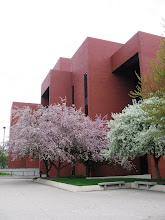Ball State Libraries Connect with Students using Web 2.0
Ball State University Libraries have entered a new phase encompassing important, exciting new applications in web-based technology and communication using Web 2.0. Among others, these include developing blogs and tags, creating video content, using RSS, web conferencing, and participating in social bookmarking. This new phase describes more an attitude than a technology. In other words, Web 2.0 does not actually refer to a specific technology; rather, it is the moniker for an emerging set of Internet-based collaborative communication tools and a new philosophy and approach on how to use them for teaching and learning.
Just as the term information superhighway helped people to grasp the possibilities of the Internet, Web 2.0 allows us to shift to another layer of the Internet. Examples of this shift include user-centric activities, such as blogging, Wikipedia, creating video content, and using mp3 players. The idea is that people who use the Web, the media, and who access the Internet should be active contributors on the Web rather than passively absorb its contents. These users help customize media and technology for their own use and that of their peer groups.
We agree with Michael E. Casey, author of the blog LibraryCrunch,* who writes ‘2.0 technologies have played a significant role in the ability of libraries to keep up with the changing needs of their library users.’
Technological advances have enabled libraries to create new services that before were not possible, such as virtual reference or downloadable media. In academic life, this new phase presents challenging, exciting ways for librarians and faculty to interact with students.
For example, a faculty member may use a content delivery method, such as a Blackboard or podcasts to provide students with access to curricular materials or to other digital material such as a videotape for students to review for classroom discussion. Service providers, student organizations, and faculty can post messages and receive feedback relevant to their interests through blogging. Short videos are easy to create and Web stream for training purposes, and the latest news or class information can be updated frequently and delivered directly to recipients.
The University Libraries seek to harness the power of these sharing networks to
· connect with students
· embrace the technology to augment teaching and learning in the classroom
· provide students with hands-on experience in using the technologies for learning and preparing assignments, for personal use, or for preparing them to use it in the workplace.
Through the latest transformation of the Internet, we are finding new ways to share news, raise awareness of services, connect with our constituent groups, and to support teaching and learning.
The list below illustrates how the University Libraries employ tools for electronic and audio/visual communication to better connect with students and faculty and to provide on-demand content for classroom instruction.
The Ball State University Libraries have been an early adopter of many new, interactive tools:
· Digital Media Repository, a collaboration with several academic units provides a growing online collection of media in formats such as slides, PDFs, audio and video files, digital images of artwork and historical photographs, and archival documents such as those from the East Central Indiana Civil War collection
· Creation of candid, user-friendly instructional videos by Information Services reference librarians that are used to instruct students as part of library instruction and literacy
· Creation of a Student Virtual Library homepage which puts students a click away from a myriad of resources for their projects and research
· Live chat with reference librarians which connects users with librarians for assistance at their desktop
· Technology training for faculty and staff by Technology Training Specialists in current technology such as classroom use of podcasts, blogs, electronic grade book and testing, among others
· Inclusion of the University Libraries on MySpace to raise awareness about library services to where the students can be found
· Really Simple Syndication (RSS) also called rich site summary tailors news items to targeted audiences about specific topics of interest happening in the University Libraries and academic libraries in general. A web site can allow other sites to publish some of its content by creating an RSS document and registering the document with an RSS publisher. A web publisher can post a link to the RSS feed so users can read the distributed content on his/her site
· Online news galleries which promote, improve, and foster communication with the Libraries’ constituencies about news, events, trends, developments, and other topics
The University Libraries continue to embrace these and other types of technology in an effort to better connect with students and the campus community at large.
For more information, contact Susan G. Akers, Ball State University Libraries’ Marketing Communications Manager, SAkers@bsu.edu, (765) 285-5031.


0 Comments:
Post a Comment
<< Home